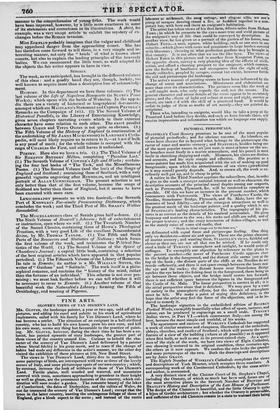FINE ARTS.
GLOVER'S VIEWS OF VAN DIEIHEN'S LAND.
MR. GLOVER, the landscape painter, a year or two ago, sold off all his pictures, and adding his easel and palette to his stock of agricultural implements, sailed with his family for Van Diemen's Land, where he has become a settler. The situation of an emigrant in a half-civilized country, who has to build his own house, grow his own corn, and kill his own meat, seems any thing but favourable to the practice of painting. Mr. GLOVER, however, during the short time he has been a Colonist, has painted upwards of sixty landscapes, the greater part of them views of the country around him. Curious to behold the character of the scenery of Van Diemen's Land delineated by a painter whose literal fidelity is his great merit, and to trace if the change of habits had made any difference in the lutist's manner, we the other day visited the exhibition of these pictures at 106, New Bond Street. The views in Van Diemen's Land, thirty-five in number, besides some paintings of birds, are interspersed with two or three of the lovely scenes of Italy, and some picturesque spots of our own country ; which, by contrast, increase the look of wildness in those of Van Diemen's Land. Fertile plains, well wooded and watered, and mountains covered with trees, sometimes approaching to grandeur in their height ' as well as gloom, are the prominent features of the country, which cultivation will soon render a garden. The romantic beauty of the lakes of Cumberland, the dales of Derbyshire, and the vallies of Wales, do not far transcend the scenery of Van Diemen's Land ; except that the trees in the latter country, wanting the umbrageous foliage of those of England, give a bleak aspect to the scene ; and instead of the rustic labourer or milkmaid, the snug cottage, and elegant villa; we area group of savages dancing round a fire, or huddled together in a tem. porary hut, with here end there an emigiant's habitation. The artist has taken views of his first farm, fifteen miles from Hobart Town ; in which he presents to the eye a more true and vivid picture of the emigrant's way of life than could be conveyed by description. In another view, he has given us a portrait of the garden of his house, near Hobart Town—a neat, square, white building, such us one sees in our suburbs—which glows with roses and geraniums in large bushes covered with blossoms ; showing to what perfection gardens may be brought in that country. It is not often that we see the like here. The views of
Hobart Town in this picture and in another from Kangaroo Point, on the opposite shore, convey a very pleasing idea of the effects of civili. zation, and afford a cheering prospect to the emigrant, which counteracts the feeling of loneliness and strangeness that the sight of wild, woody solitudes, peopled by savages, cannot but excite, however fertile the soil and picturesque the landscape. The artist's manner of painting seems to have been influenced by the change of scene and associations. Minuteness and elaboration are more than ever its characteristics. The pictures seem like the work of
a self-taught man, who only regards the end, not the means. The general character and minor details of the scene appear to be accurately given; and the affects of light and colour at noon and night, sunrise or sunset, are imit t d with the skill of a practised hand. It would be unfair to judge of them as works of art merely—they are painted de. seri ptions. Those who, intending to emigrate, would like to take a peep at the Promised Land before they decide, and such as have friends there, will receive impressions and information too which no language can supply.


























 Previous page
Previous page